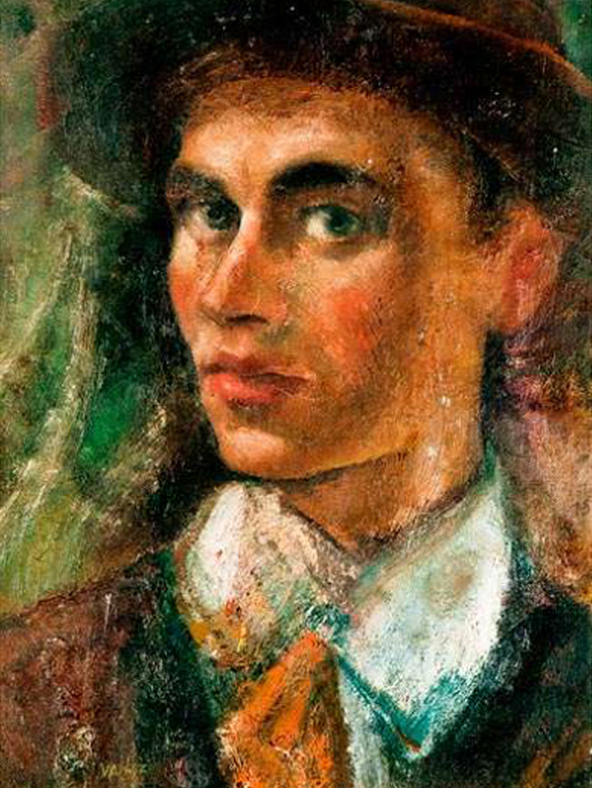Vadász Endre

Szeged, 1901 - Gödöllő, 1944
The Life
Vádasz Endre was a praised artist who knew success in both his career and personal life. He worked hard to make a name for himself and he refused to let the Nazis take that away from him.
The Art
He is known primarily for his copperplates, wood engravings, and linocuts, but he also made tempera and oil paintings. His illustrations and prints were published in several periodicals. He made hundreds of ex-libris bookplates.
Learning his place
Vádasz Endre was the second of three children, from parents Vádasz Simon Sandor and Kohn Ilona. He was born in 1901 in Szeged, in a modest Jewish family, whose livelihood was secured by the head of the family, who was a merchant.
Endre's talent for drawing surfaced at an early age. At the age of 17, he had already made an album of his teacher's caricatures and the anomalies brought about by the first world war. After finishing high school at the Royal Gymnasium in Szeged, he enrolled at the Free School (1918) in the city to learn about art, under the guidance of Heller Odon. Thanks to his teacher, he decided he wanted to be a painter. His first drawings were published in the Borsszem Jankó magazine.
Born second, but never settling for second place
In 1921, at the request of his father, he studied photography and in 1923 he graduated with a master's diploma. The same year, he was honored with the Fruchter Prize. In parallel to these studies, he enrolled at the Budapest School of Arts, where he learned from teachers like Olgyai Viktor, Zádor István, Fényes Adolf, and Glatz Oszkár. His talent was noticed from the very beginning, being the only one in his class to receive a separate model for live drawing. Later, he was appointed chief secretary of the student organization. Since the beginning of his student years and until 1927, he was a regular at showcasing art at student exhibitions. His success started appearing in 1925 when the Museum of Fine Art in Budapest acquired some of his lithographs. In the same year, he became a member of the Szinya Association and the Munkácsy Guild. Endre Vadasz's success can also be measured in the number of prizes he won. Some prizes worth mentioning are the State Merit (received between 1924 and 1926), and the Wolfner Prize (received in 1927). Between 1924 and 1927, he won a scholarship to study in Florence.
Falling in love, twice
In the summers of 1926 and 1927, his teacher, Glatz Oszkár, delegated him the task of leading the Mohács student camp. There, he met Valentin Györgyi, a young woman of Jewish descent from Baja, whom he married in 1928. The same year, he received a Nemes Marcell scholarship and went to work in Paris, where he became fascinated by Japanese woodcuts. His main subject in these years was the expressive representation of woodcutters, workers, coal miners, gardeners, and peasants.
Settling for success only
His success continued as well in the following period. In 1929, he received the silver prize in Barcelona, the upcoming year, he participated with his drawings at the Venice Biennale, and in 1931 he was honored with the Zichy Mihály prize (the most important prize for graphics). Between 1933 and 1935 he worked at the colony in Baia Mare. At this point in life, both his professional and personal life were a success. The album he made in 1936 entitled "Dance of death", included ten lithographs full of pictorial symbols representing fear and anxiety.
At the request of his wife and his gallery owner, Tamas Henrik, the family relocated from Baia Mare to Budapest. The following year, in 1937, Endre organized a personal exhibition. It was a big success. At the same time, his artworks were presented in group exhibitions in America, Amsterdam, Hague, Rotterdam, Oslo, Luxembourg, and London.
Friends in high places
As the years went by, Vádasz befriended a Dutch businessman named Win Van der Kuylen, who found his work fascinating. He quickly became a promoter of the artist. Together they traveled to western Europe between the years 1936 and 1940, where they visited Dalmatia, Italy, France, Germany, the Netherlands, and Switzerland. Through Van der Kuylen, the artist met one of the most important ex libris collectors, architect Gianni Mantero. He then got acquainted with Endre's art and bought some of his graphic works. Because their meeting was destined to lead to friendship, Mantero invited the artist to be a guest at his villa, situated on the shores of Lake Como. From an artistic point of view, this was considered to be the most colorful period in Vadasz's career.
In 1940, Endre's artwork was a part of the exhibition showcasing the movement "For Hungarian Art", opened by Horthy Miklós. The critics appreciated his paintings, considering them appealing to the eye. Between 1940 and 1944, he became a permanent exhibitor of OMIKE, the Hungarian Cultural Association.
In control of his life until the end
In 1943, World War II caught up with him and in accordance with antisemitic laws, he was summoned to the forced labor camp in Szajol. There, he kept a diary where he wrote notes on vulnerability and humiliation. The thought of losing his identity and life to the hand of the Nazis made him feel unease, so he carried out a plan to take his own life with the little dignity he had left. On June 3rd, 1944, the day before his wife was to have entered the ghetto, they both committed suicide. Even though he was rushed to the hospital, he could no longer be saved. His last note said “Bury us together”, a wish which was honored. The couple lies in the Central Jewish Cemetery in Budapest.
Gál György Sándor remembers the artist in “Memento”, a book published in 1975: “Vadász Endre's works cannot be affiliated with any school. His art represents the visions of a happy painter. He was an exceptional talent, a great painter. And a brave man …

